Flags of Opposition: Why the American Flag Isn’t Enough
Gregory Hood, American Renaissance, November 3, 2020
Symbols represent concepts, values, and ideologies that are felt more than expressed. You either understand a symbol or you don’t.
One key American symbol is the national anthem. Black singer Whitney Houston probably performed the most famous rendition of “The Star-Spangled Banner” in history. At Super Bowl XXV in 1991, a patriotic crowd cheered and roared, especially when military jets flew overhead to end the performance. That unity is gone. Today, “The Star-Spangled Banner” is racist according to the California NAACP, vandals in Baltimore, and a very large group of journalists. The NBA and NFL sometimes play the black national anthem, “Lift Every Voice And Sing,” before games.
The most important symbol for many people is their national flag. A flag is a bit of cloth, but men kill and die for it. People say burning their flag is “desecration,” just as Roman Catholics are sickened to imagine the Communion Host defiled. A national flag is the symbol of a people. It’s the one thing everyone should feel belongs to them.
It’s also what changes when there is “State Conquest,” when a new ruling class — or a new people altogether — takes power. South Africa today limits the use of its historic flag. Rhodesia became Rhodesia/Zimbabwe and then Zimbabwe, with new flags at each stage. A Republican state legislature in Mississippi preemptively surrendered in the culture war by voting to replace the state flag because of the Confederate battle flag in the canton. The battle flag was once so common that the Southern Poverty Law Center founder Morris Dees could say it was part of his heritage. In 2015, Governor Nikki Haley (née Nimrata Randhawa) removed it from the South Carolina statehouse. She will almost certainly be a contender for the GOP nomination in 2024.
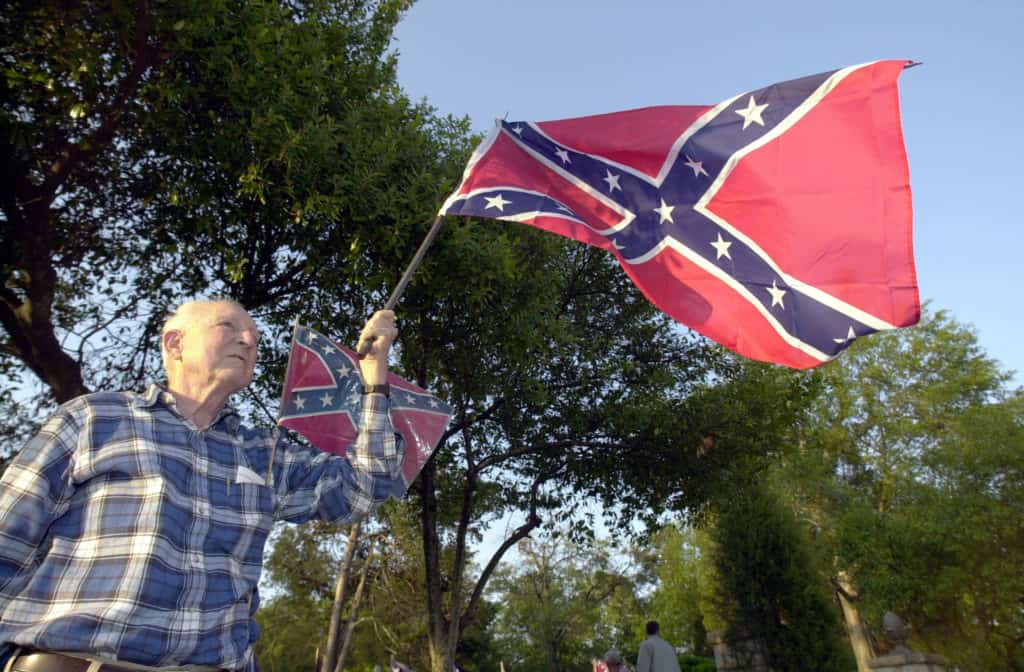
Credit Image: © Erik S. Lesser / ZUMAPRESS.com
The American flag no longer unites us. Many who hold American passports do not consider themselves “American.” People burn the American flag so often it’s not even news. Often, those who burn it are blacks or Hispanics, the people who get special benefits from the government. Many people vent hatred for the United States on the Fourth of July.
President Trump wants to make it illegal to burn the flag, but that would violate the First Amendment. It’s illegal to steal someone else’s American flag and burn it, though that would be a minor crime. By contrast, when a Hispanic man burned the rainbow “gay pride” flag, a judge sentenced him to 16 years in prison for a “hate crime.” When someone burned a rainbow flag in Kansas in 2019, NBC News gave it national coverage and authorities investigated it “as a hate crime.”
Whom does the American flag represent today? Conservatives are generally more patriotic than liberals and whites more than non-whites. However, the American flag doesn’t belong exclusively to whites. If America is an idea, it belongs to everyone. Even the “idea” is up for grabs. What “ideas” do Alexandria Ocasio-Cortez or Ilhan Omar share with Washington or Jefferson?
If we say the American flag represents the government, it is the banner of a system that is replacing its own population. Some government employees evidently don’t think the American flag sufficiently represents them, even in an official capacity. The American embassy in South Korea displayed the rainbow flag and the Black Lives Matter logo; CNN called it a challenge to the Trump Administration.
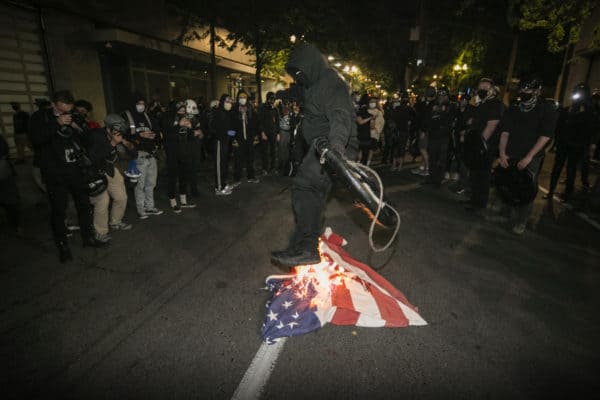
September 21, 2020,: George Floyd Protests in Portland, Oregon. (Credit Image: © HÖÖK Pontus/TT via ZUMA Press)
Immigration patriots know that people marching for amnesty for illegal aliens often wave the national flags of their “real” countries. When Hispanics protested Proposition 187, which withheld state benefits for illegals in California, some marched under the Mexican flag or even held signs that read “Mexicans against 187.” (This proves the state needed Proposition 187.)
In 2006, countless aliens waved the flags of their homelands in large pro-amnesty marches. In 2011, Hispanic students in Texas waved Mexican flags when they walked out of public schools to protest immigration law enforcement. In 2015, an American public high school tried to stop an American student from flying an American flag on his pickup truck. The school backed down, but it was a remarkable example of a state institution banning its “own” symbol.
Many people think the American flag is controversial. Psychology Today said it “can be seen as representative of white (and male) power.” In July, Virginia state officials told a contractor to take down an American flag at a construction site because protesters might “target” it. In Hawaii, where there is a strong secessionist movement, residents protested an Independence Day display of American flags. There are countless similar stories.
This is a problem for whites. Leftists can fly the American flag if they like, but they can also claim it’s “offensive” or “racist.” Ultimately, it represents a government that doesn’t defend white interests. Is there a flag that symbolizes white identity? The white sun cross may be the best known “white nationalist” flag, but is on the fringe and is too foreign for most Americans.
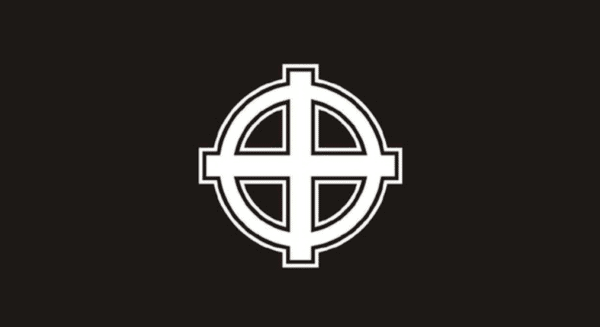
The first “American” flag, the Betsy Ross flag, is an implicitly white flag. Colin Kaepernick, whom Nike supports, forced his sponsor to recall shoes that displayed the flag. It is certainly part of our heritage, but it cannot be our flag if we are trying to imagine a new future for our people. We cannot return to the Old Republic. Still, it has potential, though it has the same problem as the first national Confederate flag (“the Stars and Bars”): It looks too much like the current American flag.
The better known “Confederate flag” was the battle flag of Robert E. Lee’s Army of Northern Virginia. This is a historic flag for white Southerners, and is also a larger symbol of rebellion. Today, it represents white working-class resistance against America’s cultural elite. This has potential for us because it has outlived its past, but it’s ultimately a symbol that looks back, rather than ahead. Some black Southerners also claim it, which can lead to amusing showdowns.

One interesting flag is the combined Confederate battle flag/American flag. After Reconstruction, Union and Confederate veterans hosted joint commemorations. Today, some historians and journalists say reconciliation was a trick to cover up the Confederacy’s “defining cause” of slavery. However, it was really a way of binding up the nation’s wounds. Abraham Lincoln understood this, which is why he praised the Confederate national anthem “Dixie” when he went to Richmond in 1865. White Southerners flew the “Rebel Flag” in World War II and in Vietnam, seeing no contradiction in honoring the South and fighting for Uncle Sam. The combined Union/Confederate flag is aesthetically questionable but ideologically consistent. It’s a symbol of the historic American nation, the white core that built and sustains the Republic.
However, revisionist historians have a point: Post-Reconstruction unity between North and South was possible because the North “gave up” on forcing black rule on the South. This changed when President Eisenhower used the 101st Airborne to integrate Little Rock schools and Presidents Kennedy and Johnson used federal power to enforce “civil rights” legislation. Some Southern leaders flirted with secession again, but the opportunity passed. Thanks to mass immigration, Georgia, North Carolina, Texas, and other states may be under permanent leftist rule — just like once-conservative Virginia, Colorado, and California.
Eric Foner and other influential academics argue that Reconstruction’s problem was that it wasn’t harsh enough. This is the new orthodoxy in universities. It’s also hard not to see this view as a trial balloon for what many want to unleash against Donald Trump supporters. Former Secretary of Labor Robert Reich has already said we “need” South African style “Truth & Reconciliation Committees.” In this context, the battle flag may take on new meaning.
When this nightmare is over, we need a Truth and Reconciliation Commission. It would erase Trump’s lies, comfort those who have been harmed by his hatefulness, and name every official, politician, executive, and media mogul whose greed and cowardice enabled this catastrophe.
— Robert Reich (@RBReich) October 17, 2020
The Gadsden flag has larger mainstream appeal, and the historic yellow banner became the symbol of the Tea Party movement. Unfortunately, the Beltway Right co-opted it, and the Tea Party failed to stop government spending or even Obamacare. The black variant has more a militant look that I like, but it’s too vague a symbol of defiance, like the various “Come and Take It” flags.
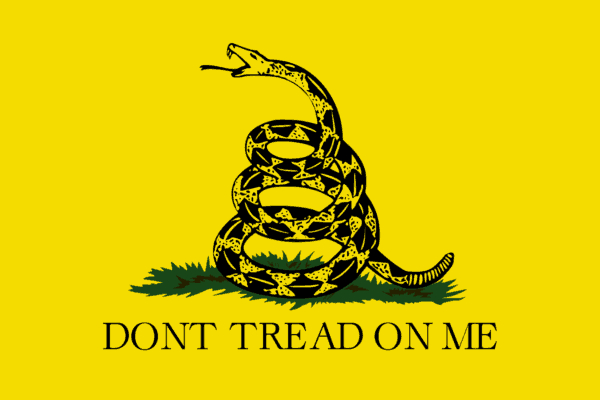
Defiance can spark creativity, and new flags are appearing in response to Black Lives Matter. The most famous is the “Blue Lives Matter” flag, with a black and white Stars and Stripes and the thin blue line that separates civilization from chaos. President Trump’s campaign used it at rallies. The Marshall Project said “white supremacists” flew it at Charlottesville in 2017, but they also flew the American flag.
There are variations with a red line (for firefighters) and others for various “first responders.” The problem is that these flags represent state officials, who may be secretly “on our side” but who follow orders. If police are told to arrest gun owners or dissidents, most will. It was just after protesters at Unite the Right 2017 chanted “blue lives matter” that state troopers gassed them and drove them into the ranks of antifa. Still, the flag shows resistance to BLMania.
The Trump 2020 flag, in its several variations, captures something beyond support for a candidate. Some say “Make America Great Again.” Others say, “Keep America Great,” though these have become less common during the campaign. A common one reads “No More Bullshit.” Each person who flies it has his own opinion about what that means, but it would be hard to argue that it doesn’t represent a yearning for a strong executive to suppress mobs, reject political correctness, and control the permanent bureaucracy (the “Deep State”).
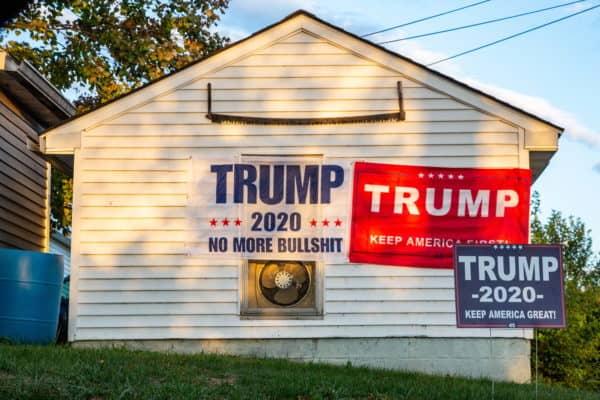
October 7, 2020, Milton, Pennsylvania, United States: Trump signs and flags adorn a shed in rural Northumberland County near Milton, Pennsylvania. (Credit Image: © Paul Weaver/Pacific Press via ZUMA Wire)
The aesthetic contrast between the Trump campaign and the Biden campaign reflects this. President Trump projects strength and leadership. Joe Biden wears a mask, takes a knee, and is the face of a system for which he would be a figurehead.


Unfortunately, the Trump flags leave whites in the same trap as the American flag. President Trump has accomplished great things against incredible odds, and I hope he wins, but he won’t save us. At best, he bought us a stay of execution. At worst, he energized the left without protecting us from it.
The MAGA movement may be implicitly white, but implicitly white movements haven’t solved the problems we face today. We are in a Race Against Time, to borrow one of Jared Taylor’s book titles, and time is almost out. We can’t afford more implicit movements, symbols, or ideologies when Texas or Georgia will be solid blue in a few years, regardless of what happens today. We can support police officers, but they may be forced to arrest us for exercising freedom of speech if progressives can find a way around the First Amendment. The Constitution won’t save us either.
We face a national, civilizational, and racial crisis. We need a movement that is explicitly white, that defends our interests as whites. We can no longer tolerate being treated as second-class citizens in the country we built. If we submit, we deserve everything that’s coming to us.
White identity may even save the United States of America by halting the complicated schemes to achieve an impossible racial “equity.” If America is to be a multiracial empire, our rulers should at least protect our borders, stop replacement migration, promote positive values, patriotism, and national pride. If instead, our rulers cheer on the descent into a “victimhood culture,” we whites will be the scapegoats. In that case, we need a place of our own — even if that means a separate country.
We need a banner around which to rally. What symbol captures our spirit of identity, unity, and will to survive? I don’t know. It is something yet to appear. Perhaps it will be the old battle flag, but I suspect something new will emerge.
Martin Heidegger famously said in 1966 that “only a god can save us,” but warned that we can’t “bring him forth by thinking.” Instead, we can “awaken a readiness to wait [for him].” In other words, it’s not a question of opening MS Paint and making a flag. Instead, it will come to us, a spirit and a symbol that will emerge from our struggle.
This is something we can’t force, any more than we forced Donald Trump to appear as an unwitting defender of white interests. We can’t just pick a symbol or a figure and go from there.
Leftists will keep tearing down implicitly white American symbols and institutions. In response, a historic flag could take on a new meaning. If the federal government imposes more policies hostile to us, whites may lose all affection for the American flag or any historic flag. The Stars and Stripes could go from being a sacred symbol for whites to a sign of hostile occupation.
Many Americans have switched flags. Countless Confederate officers who fought against the Union had once served under the Union flag. Robert E. Lee turned down the command of United States forces before deciding to fight for Virginia. A young George Washington fought with the British, killing Frenchmen in North America. An older George Washington fought with the French, killing Britons.
The remarkable grassroots enthusiasm for Mr. Trump, even in the face of repression and hatred, shows that whites want to fight for something. They don’t want America to die. They don’t want to give up on the dream. Even if America collapses, I suspect whatever follows will be the spiritual successor to the United States, rather than a complete break. It would like the Holy Roman Empire that emerged from the fall of the real Roman Empire.
Spiritual, cultural, and political movements don’t follow orders. We can’t choose the “right” flag or ideology and expect Americans to follow. Instead, we can participate in the struggle in every way we can, whether by writing, speaking, organizing, or donating. I have confidence — even faith — that if we do this, European-Americans will regain their self-respect. We will either save this country or raise a banner over something new. The countless flags of opposition — of all kinds — defying the political, cultural, and financial elites are proof that people yearn for something. When it finally emerges, it will seem obvious in retrospect.
1 Corinthians 13:12 reads: “For now we see though a glass, darkly, but then face to face: now I know in part, but then I shall know even as also I am known.” I don’t mean to blaspheme, but if a people is to survive, it must have a shared sense of fate, purpose and destiny. I see European-Americans searching for those things. I see them expressed, however imperfectly, in protest flags flying across this country. Something is coming, much bigger than Donald Trump.















